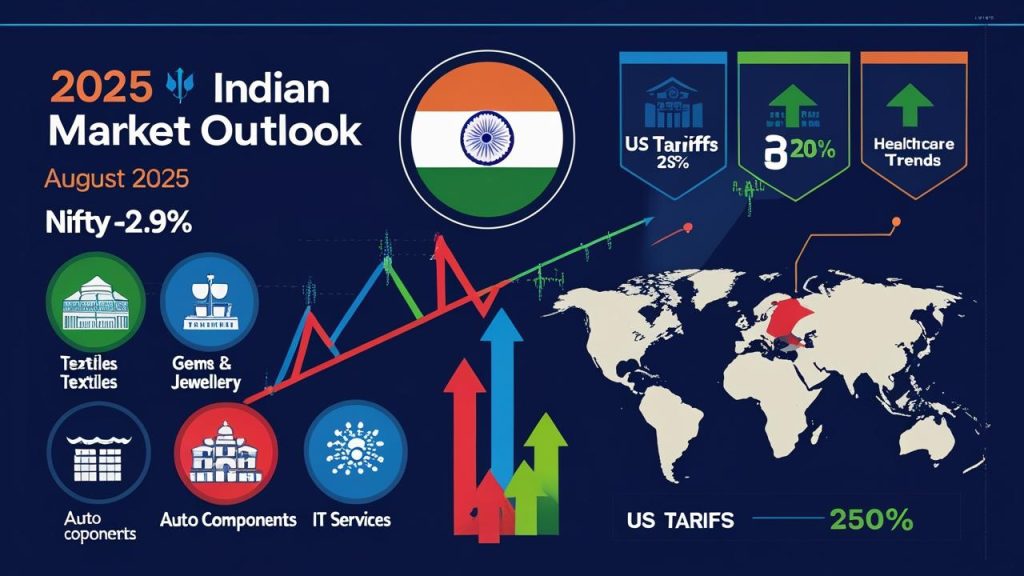
“Growth comes from chaos, not order.” – Rakesh Jhunjunwala
Equity markets dipped in July’25 after gaining for four consecutive months, weighed down by mixed earnings, FII outflows and uncertainty around India-US trade deal and tariffs. Nifty50 fell 2.9% (-749 points) in Jul’25, to close at 24,768. Broader markets significantly underperformed with Midcap and Small cap Indices declining by 2.3% each.
All sectors ended the month with decline except healthcare. India failing to secure a trade deal with US and slowing domestic growth weighed on sentiments. On the contrary, all major global equity markets witnessed rally in July.
FIIs ended their four-month buying streak, with outflows of ₹47,667 crore in July’25, while DII inflows remained healthy at ₹60,939 crore. Weak domestic Q1 earnings dampened sentiment. Dimming hopes of the possibility of a deal between India and US before Aug-25 and US levying 25% tariffs on India and countries buying oil from Russia led to persistent foreign fund outflows.
Global central banks maintained a cautious stance amid persistent inflation concerns and mixed economic signals. The US Fed, ECB, BoJ and BoE kept rates unchanged. RBI too held its policy rate steady, reiterating its focus on inflation control amid resilient domestic growth.
On the trade front, the US imposed a 25% tariff on all goods imported from India, effective August 7, 2025. Additionally, it announced a 25% penalty linked to India’s trade relations with Russia. These developments pose short-term headwinds for export-oriented sectors such as IT, Pharma, Automobiles, and Textiles, until a trade agreement is reached with the US.
Tariffs & their impact on Indian Stock Markets
- Tariff Surprise: US has raised tariffs on Indian goods to over 25%, with an additional 25% penalty linked to India’s dealings with Russia.
- Limited Market Impact: Most listed Indian companies have a predominantly domestic revenue. India’s key global sectors like Pharma and IT remain unaffected so far. Industries with large export contribution from US (Textiles, Gems & Jewellery) do not have significant listed presence, although with them being large employers, second-order impact on rest of the economy needs to be watched out for.
- Watchful Optimism: Tariffs may be part of US negotiating tactics, with talks expected to continue later this month. India can use this situation to double down on reforms and diversify its global trade partnerships.
While India was one of the first countries to start negotiating with US, trade talks with US seem to have hit a roadblock owing to India’s reluctance to cede ground on Agriculture and Dairy leading to the current impasse.
Which sectors could be impacted?
- Textiles: The US is India’s biggest textile export market, making up ~50% of India’s Textile exports. India’s export competitiveness boosted by China+1 and instability in Bangladesh could now be offset by the new US tariff. Further, countries like Vietnam with competitive cost of production have relatively favourable tariff (20%) too.
- Gems and Jewellery: With ~30% of its total exports going to US, steep tariff increase could impact this sector, more so in the unlisted space. As a large employer of labour, impact of tariff on this sector needs to be monitored.
Relief for key sectors though!!
- Pharma: While US remains a key market, Pharmaceuticals remain exempt from its newly expanded tariff regime. Given their critical role in affordable healthcare (40% of US’s generic drug demand), Indian drugmakers are likely to stay resilient, highlighting the sector’s key role in India-US trade.
- Auto components: Auto components are already subject to 25% tariff since May’25 and is exempt from the country-specific reciprocal tariffs. Since the levy on auto parts is the same for all countries, there is no impact on competitiveness of products made in India.
- IT Services: India’s largest services export category remains untouched as services have been out of purview.
No need to press the Panic Button
India’s economy is largely domestic-driven in nature and barely 10% of NIFTY 500 companies’ revenue is driven by exports. Revenue from US is even lower.
Sectors most impacted by US tariffs happen to be Gems & Jewellery, Leather and Textiles which do not have large representation in the listed space. Pharmaceuticals and Electronics remain in the exempted list.
While US is a key export destination, India has a wide array of key trading partners for most industries. India could aim to strengthen ties with other economies through FTAs like the India-UK deal recently.
India can use this crisis to double down on Aatmanirbhar Bharat and Make in India, cutting reliance on imports in key sectors. Reforms aimed at boosting labour productivity and faster adoption of technology could be imperative to make Indian manufacturing globally competitive and less vulnerable to such events.
Going
by recent developments, the latest round of reciprocal tariff may not be cast
in stone. Deadlines have been extended multiple times earlier too.
With another round of discussion scheduled later in August, the
recent announcement could well be a bargaining tool for US.
Further, Inflationary impact of Tariffs on US economy cannot be
undermined.
Key Takeaway: While the US tariff hike presents a short-term hurdle for select export sectors, the broader impact on India’s economy and equity market remains limited. India’s domestic consumption-driven growth, resilient listed space, and diversified trade ties act as strong buffers. Considering India’s undeniable importance as a large consumer market, there is a reasonable likelihood of a mutually beneficial deal culminating between India and US. For investors though, this is a reminder that diversification across sectors and asset classes is a key pillar of investing.

